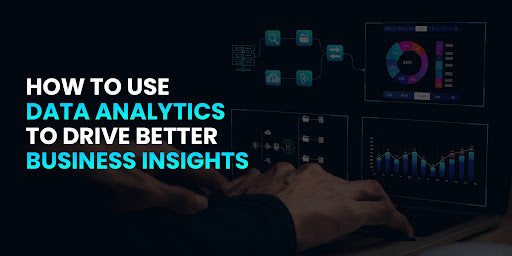
How to Use Data Analytics to Drive Better Business Insights?
In today's fast-paced digital landscape, businesses are inundated with vast amounts of data. However, the true value lies not just in collecting this data, but in leveraging its potential to drive actionable insights.
In our blog, we delve into the transformative power of data analytics and how it can be leveraged to propel businesses forward. From understanding customer behavior to optimizing operations, we will explore the strategies and tools that can help unlock invaluable insights and drive better business outcomes.
What is data analytics?
Data analytics is like being a detective for information! It's about taking all the bits and pieces of data scattered around (like sales numbers, website visits, or even your fitness tracker data) and using them to solve mysteries and uncover hidden patterns.
Now you must be thinking how it is useful for your business. Imagine if you will get to know which age group of people are reading your blogs most attentively or how many people are giving positive and negative reviews of your business app. Won’t it be helpful to interpret the position of your firm in the market and suggest improvements?
Why do you need data analytics?
In today's data-driven world, information is abundant, but understanding it is crucial. That's where data analytics comes in. There are several compelling reasons why it's become so important:
Make Better Decisions
Data gives us objective facts, not just gut feelings or assumptions. Analytics helps us interpret that data, identifying trends, patterns, and correlations we might miss otherwise. This empowers us to make informed decisions, backed by evidence, leading to better outcomes in various fields like business, healthcare, and even personal life.
Improve efficiency and productivity
Data reveals inefficiencies and areas for improvement. By analyzing performance data, organizations can optimize processes, streamline operations, and allocate resources more effectively. This translates to cost savings, increased productivity, and improved service delivery.
For example, the ‘Insights’ section of TapOnn allows you to check various data analytics like ‘Profile Tap’ and ‘Tap Through Rate’ , Link engagement which help you to understand where your connections are most interested in.
(Caption: Insights Tab of TapOnn allows you to check data analytics)
Gain a Competitive Edge
In today's competitive landscape, understanding your customers and market is crucial. Data analytics helps businesses segment audiences, personalize social media campaigns by using social media metrics, predict customer behavior, and develop innovative products and services that truly resonate with their target market. This can lead to increased sales, market share, and brand loyalty.
Innovate and Discover New Opportunities
Data can unveil hidden patterns and connections that we might not have realized. By analyzing vast datasets, researchers and scientists can make groundbreaking discoveries in areas like medicine, technology, and social sciences. This leads to advancements that benefit society as a whole.
Solve Complex Problems
From tackling climate change to managing traffic congestion, many complex problems require a data-driven approach. By analyzing diverse data sources, we can gain a deeper understanding of the problem, identify root causes, and develop effective solutions that consider various factors and potential impacts.
How to use data analytics for business?
Data analytics has become a game-changer for businesses, providing valuable insights to drive informed decisions and achieve success.
Let's explore how you can implement data analytics efficiently using four key steps:
Define Clear Objectives
Start with the WHY
What specific problems are you trying to solve, or what goals do you want to achieve? Are you aiming to improve customer satisfaction by knowing your customers better, optimize marketing campaigns, or increase sales? Clearly defined objectives guide your data collection and analysis efforts.
Quantify your goals
Set measurable targets for your objectives. For example, aim to increase website conversion rates by 10% or reduce customer churn by 5%. Quantitative goals help track progress and assess the effectiveness of your data-driven strategies.
Collect Relevant Data
Once you set up your objectives, now you need to collect the data for analysis.
Identify data sources
Look for internal data like sales figures, website analytics, and customer surveys. Consider external data sources like market research reports and social media mentions.
Ensure data quality
Clean and organize your data to ensure accuracy and consistency. Identify and address missing values, outliers, and duplicates. Remember, ‘garbage in, garbage out’ – the quality of your data directly impacts the quality of your insights.
Prioritize data security
Implement robust data security measures to protect sensitive information and comply with relevant regulations.
Choose the Right Tools and Techniques
Different analytics tools excel at different tasks. For descriptive analysis, consider spreadsheets and basic visualization tools. For predictive modeling, explore machine learning algorithms and specialized software. Choose tools that align with your team's skills and resources. Invest in training if needed to leverage the chosen tools effectively. Start small and experiment with different tools and techniques to find the best fit for your specific needs and data sets.
Keeping a track of your network is a significant step when it comes to a successful business. Apart from your customers, you need to connect with everyone in your internal or external network. TapOnn is a significant tool which simplest your networking strategies on a single digital platform and also provides the insights of your profile, making it easy for you to increase your Network and maintain your presence in the business world.

Data Visualisation
The final steps to present your analysis in the forms of graphs and diagrams so that you can visualize the trends. Here are few suggestions for data visualization:
Make it clear and compelling
Translate complex data into easily understandable visuals like charts, graphs, and dashboards. Ensure clear labeling, consistent formats, and color schemes to avoid misinterpretations.
Highlight key insights
Use visuals to emphasize significant findings, trends, and relationships within the data. Don't be overwhelmed with visuals; focus on communicating the most impactful information.
Tell a story with data
Use visuals to narrate the journey from data to insights to actionable recommendations. Create a compelling narrative that resonates with your audience and drives decision-making.
Boost your Business Growth
In conclusion, harnessing the power of data analytics is imperative for businesses striving to stay competitive and make informed decisions in today's dynamic landscape. By leveraging advanced analytical techniques and tools, organizations can uncover valuable insights from their data, enabling them to identify trends, anticipate customer needs, optimize processes, and ultimately drive growth and innovation. As technology continues to evolve and data volumes grow, businesses that prioritize data analytics will undoubtedly gain a strategic advantage, unlocking new opportunities and staying ahead of the curve in an increasingly data-driven world.



